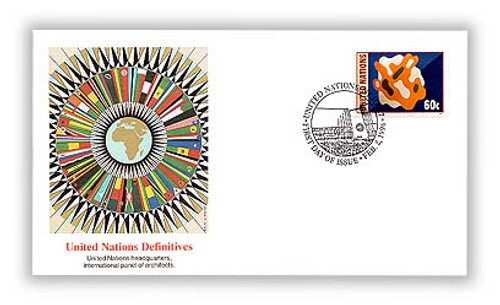
# 7267428 - 1997 60c NY Terracotta Warriors
1997 Terra Cotta Warriors FIrst Day Cover
UN Offices in New York
Celebrating the 25th anniversary of the World Heritage Convention, the U.N. issued six stamps featuring China’s terracotta warriors, which are protected under the Convention. Adopted in 1972, and signed by more than 145 countries, this international treaty identifies, protects, and preserves cultural and natural heritage around the world, which is considered to be of outstanding value to humanity.
On March 29, 1974, the Terracotta Warriors were discovered. The collection of over 8,000 life-sized figures is the largest pottery figurine group found in China.
The figures were created as part of the tomb of Qin Shi Huang, the first emperor of China. A form of funerary art, they were buried with the emperor around 210-209 BCE to protect him in the afterlife.
Work on the tomb complex began in 246 BCE, shortly after the 13-year-old Emperor Qin took the throne. Work on the massive mausoleum would eventually include about 700,000 workers. In addition to the statues, the complex included palaces, towers, valuable artifacts and reportedly 100 flowing rivers of mercury.
On March 29, 1974, three farmers were digging a well less than a mile from the emperor’s tomb at Mount Li when they found pieces of pottery. This prompted a group of Chinese archaeologists to come and see the discovery for themselves. They then began to carefully excavate the site and eventually unearth the largest pottery figurine group ever found.
The archaeologists found three distinctly separate vaults holding 8,099 life-sized terracotta soldiers and horses. Further analysis revealed the figures were crafted during the reign of Qin Shi Huang (259-210 B.C.).
Each of the life-sized figures is unique in height, hair, and facial features. In addition, the terracotta soldiers are posed realistically, including standing infantry, kneeling archers, and charioteers. Modern attempts to duplicate the excellence of the ancient terracotta have failed to achieve the same high level of luster, density, and durability.
The figures were found in three separate pits representing different sections of the army. The largest pit holds the infantry, arranged in practical battle formation. A line of 204 warriors wearing battle clothes stand armed with bows and arrows. Another row of soldiers represent the flank and rear guard. A cluster of detailed chariots and warriors represent the main force.
The second pit holds the cavalry, infantry, archers, and charioteers. Early indications suggest the pit may hold as many as 350 terracotta horses, 100 cavalry steeds, and over 900 warriors. A third pit held the officers. Several more vaults exist but have not yet been excavated. It’s estimated the entire complex spans about 38 square miles. Archeologists estimate this Terracotta Army study will take 50 years to complete.
The Terracotta Army was situated between the emperor’s tomb and enemy territory, leading historians to believe Qin Shi Huang had the figures created and buried with him to protect him in the afterlife. The United Nations declared the region a World Heritage Site in 1987.
1997 Terra Cotta Warriors FIrst Day Cover
UN Offices in New York
Celebrating the 25th anniversary of the World Heritage Convention, the U.N. issued six stamps featuring China’s terracotta warriors, which are protected under the Convention. Adopted in 1972, and signed by more than 145 countries, this international treaty identifies, protects, and preserves cultural and natural heritage around the world, which is considered to be of outstanding value to humanity.
On March 29, 1974, the Terracotta Warriors were discovered. The collection of over 8,000 life-sized figures is the largest pottery figurine group found in China.
The figures were created as part of the tomb of Qin Shi Huang, the first emperor of China. A form of funerary art, they were buried with the emperor around 210-209 BCE to protect him in the afterlife.
Work on the tomb complex began in 246 BCE, shortly after the 13-year-old Emperor Qin took the throne. Work on the massive mausoleum would eventually include about 700,000 workers. In addition to the statues, the complex included palaces, towers, valuable artifacts and reportedly 100 flowing rivers of mercury.
On March 29, 1974, three farmers were digging a well less than a mile from the emperor’s tomb at Mount Li when they found pieces of pottery. This prompted a group of Chinese archaeologists to come and see the discovery for themselves. They then began to carefully excavate the site and eventually unearth the largest pottery figurine group ever found.
The archaeologists found three distinctly separate vaults holding 8,099 life-sized terracotta soldiers and horses. Further analysis revealed the figures were crafted during the reign of Qin Shi Huang (259-210 B.C.).
Each of the life-sized figures is unique in height, hair, and facial features. In addition, the terracotta soldiers are posed realistically, including standing infantry, kneeling archers, and charioteers. Modern attempts to duplicate the excellence of the ancient terracotta have failed to achieve the same high level of luster, density, and durability.
The figures were found in three separate pits representing different sections of the army. The largest pit holds the infantry, arranged in practical battle formation. A line of 204 warriors wearing battle clothes stand armed with bows and arrows. Another row of soldiers represent the flank and rear guard. A cluster of detailed chariots and warriors represent the main force.
The second pit holds the cavalry, infantry, archers, and charioteers. Early indications suggest the pit may hold as many as 350 terracotta horses, 100 cavalry steeds, and over 900 warriors. A third pit held the officers. Several more vaults exist but have not yet been excavated. It’s estimated the entire complex spans about 38 square miles. Archeologists estimate this Terracotta Army study will take 50 years to complete.
The Terracotta Army was situated between the emperor’s tomb and enemy territory, leading historians to believe Qin Shi Huang had the figures created and buried with him to protect him in the afterlife. The United Nations declared the region a World Heritage Site in 1987.






